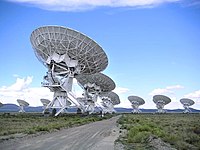Telescope
A telescope (from the Greek tele = 'far' and skopein = 'to look or see'; teleskopos = 'far-seeing') is an instrument designed for the observation of remote objects. The term usually refers to optical telescopes, but there are telescopes for most of the spectrum of electromagnetic radiation and for other signal types.
Types of telescope

Optical telescopes
An optical telescope gathers and focuses light mainly from the visible part of the Electromagnetic spectrum (although some work in the infrared and ultraviolet). Optical telescopes increase the apparent angular size of distant objects, as well as their apparent brightness. Telescopes work by employing one or more curved optical elements - lenses or mirrors - to gather light or other electromagnetic radiation and bring that light or radiation to a focus, where the image can be observed, photographed or studied. Optical telescopes are used for astronomy and in many non-astronomical instruments including theodolites, transits, spotting scopes, monoculars, binoculars, camera lenses, and spyglasses. There are three main types:
- The refracting telescope which uses solely an arrangement of lenses.
- The reflecting telescope which uses solely an arrangement of mirrors.
- The catadioptric telescope which uses a combination of mirrors and lenses.
Radio telescopes
Radio telescopes are directional radio antennae that often have a parabolic shape. The dishes are sometimes constructed of a conductive wire mesh whose openings are smaller than the wavelength being observed. Multi-element Radio telescopes are constructed from pairs or larger groups of these dishes to synthesize large "virtual" apertures that are similar in size to the separation between the telescopes: see aperture synthesis. As of 2005, the current record array size is many times the width of the Earth, utilizing space-based Very Long Baseline Interferometry (VLBI) telescopes such as the Japanese HALCA (Highly Advanced Laboratory for Communications and Astronomy) VSOP (VLBI Space Observatory Program) satellite. Aperture synthesis is now also being applied to optical telescopes using optical interferometers (arrays of optical telescopes) and Aperture Masking Interferometry at single reflecting telescopes.
X-ray and gamma-ray telescopes
X-ray and gamma-ray telescopes have a problem because these rays go through most metals and glasses. Some x-ray telescopes use ring-shaped "glancing" mirrors, made of heavy metals, that reflect the rays just a few degrees. The mirrors are usually a section of a rotated parabola. Gamma-ray telescopes give up on focusing entirely, and use coded aperture masks; the pattern of shadows the mask creates can be reconstructed to form an image.
These types of telescopes are usually on Earth-orbiting satellites or high-flying balloons, since the Earth's atmosphere is opaque to this part of the electromagnetic spectrum.

Other types
Notable telescopes

- Anglo-Australian Telescope
- Arecibo Observatory
- Atacama Large Millimeter Array
- Chandra X-ray Observatory
- CHARA (Center for High Angular Resolution Astronomy) array
- Hale telescope
- Hexapod-Telescope
- Hooker Telescope
- Hubble Space Telescope
- IceCube Neutrino Detector
- Isaac Newton Telescope
- Keck telescope
- LIGO
- McMath-Pierce Solar Telescope
- McMath-Hulbert Observatory (Solar)
- Magdalena Ridge Observatory
- Navy Prototype Optical Interferometer
- Parkes Observatory
- Southern African Large Telescope
- Subaru Telescope
- UK Schmidt Telescope
- Very Large Array
- Very Large Telescope
- William Herschel Telescope
- XMM-Newton
This list is incomplete; you can help by adding missing items. |
See also
- Amateur telescope making
- Angular resolution
- Aperture synthesis
- ASCOM open standards for computer control of telescopes
- BOOTES
- Depth of field
- Dynameter
- Eyepiece
- First light
- f-number
- History of telescopes
- Keyhole problem
- List of largest optical reflecting telescopes
- List of largest optical refracting telescopes
- Microscope
- Remote Telescope Markup Language
- Robotic telescope
- Timeline of telescope technology
- Timeline of telescopes, observatories, and observing technology
